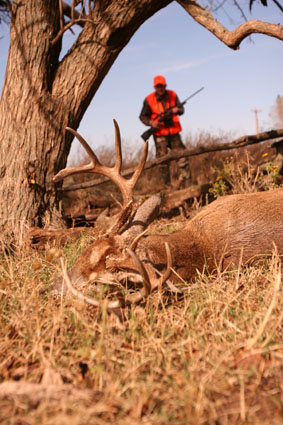 The buck’s role in the rut has been well-documented. Hunters should read everything they can get their hands on to understand fully all the facets of a whitetail buck’s daily rituals. The more a hunter learns about his quarry, the better hunter he will be.
The buck’s role in the rut has been well-documented. Hunters should read everything they can get their hands on to understand fully all the facets of a whitetail buck’s daily rituals. The more a hunter learns about his quarry, the better hunter he will be.
Like the doe, a buck is also impacted by the fall photoperiod cycle with declining hours of daylight. This triggers a series of biochemical changes that lead to the buck participating in the three phases of the rut, each with its own set of characteristic behaviors and activities fulfilling the whitetail breeding process.
At the center of these changes is testosterone. As the levels increase in early fall, the buck starts to make rubs. Later, as the biochemical level rises, the buck begins to make scrapes. All this is to mark territory, warn intruding bucks and perhaps to attract does. Much later, buck testosterone levels peak, as do doe estrogen levels.
These incidences coincide at a unified period we know as the peak rut. Your state wildlife agency should publish information about the average peak rutting dates in your area. Hunters should spend heavy doses of time in the woods two or three weeks prior to these peak rut dates and a couple of weeks or more afterward. Hunt fresh rubs and scrapes, doe-buck travel routes and doe yarding and feeding areas.
This was the very short course. Much more should be studied about the dominance, seeking, chasing, tending and breeding phases. Whitetail hunting should be a dedicated lifelong endeavor. Consistent success demands it.
Using Buck Scents To Hunt Bucks
Bucks are highly competitive in nature during the rut — especially in terms of protecting their territorial grounds. Given they are jealous of any intrusions by other bucks, some hunters have turned to using buck urine-based scents to rile competing bucks into exposing themselves. This can be especially successful during the early rut phase as bucks begin to make and work scrapes. Is this a viable tactic?
“Not necessarily,” says Ron Bice of the Wildlife Research Center, a product leader in hunting scents and human scent killers. “It depends on the timing. I still think an estrus scent has the highest draw when the rut is near. With all scent and other lures for that matter, if the scent setup is pristine and not contaminated by human scent, the odds increase tremendously.”
T.R. Michels of Trinity Mountain Outdoors says, “I’ve often had my best results with buck urine a week or two before peak breeding, because dominant bucks want to know which bucks are intruding in their area. They will instinctively exert their dominance over lesser bucks in the area, so the use of buck urines triggers those impulses.”
Buck urine or estrus scents? Toss a coin or use both selectively. Empirical evidence seems to suggest there is a useful time and place for both.






